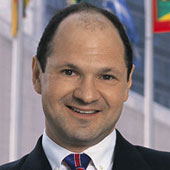Is Manhattan in Europe?
Have Russians turned London into a theme park for the rich and famous of the world?
March 18, 2004
If it weren't for the fact that there is already a big city by that name in Arizona, Manhattan should have by rights been called Phoenix — given its ability to revive and revitalize itself.
Three decades ago, New York City was broke and depopulated. And while some life still seemed to flicker in the outer boroughs — especially in Brooklyn and Queens — Manhattan was close to being given up for dead.
Real estate values plummeted, the middle classes fled — and businesses were rapidly evacuating their production and office facilities.
But by mid-1990s, Manhattan was re-emerging as the most desirable — and by far the most expensive — place to live in the United States.
It did so by becoming the playground of the rich and famous — the international glamour set, the Hollywood stars and the like.
And, of course, New York City has been enjoying a continued boost from the revival of its traditional industries — high-end services, banking, finance and advertising.
These boom-or-bust industries attract people who in good times — and even not-so-good ones — tend to spend with gay abandon.
It stands to reason that Europe — which in recent decades has been aspiring to become the United States of Europe — should also develop such a post-modern, ephemeral playground of its own.
And it is no surprise that London should become such a theme park for the global wealthy.
After all, not only does the United Kingdom fancy itself a special ally of the United States, but London and Manhattan also share a number of uncanny similarities.
Just like Manhattan, London seemed to be on its last legs only 10 years ago. The housing market had collapsed, and those unhappy Brits who had bought homes during the late 1980s property boom had suffered painful financial losses.
Worse, there was seemingly no prospect for a speedy recovery. Just like Manhattan, London had lost most of its industry, while its status as Europe's financial center looked to be increasingly at risk.
The impending advent of the single European currency seemed bound to shift the financial hub onto the continent, most likely to Frankfurt.
But, London — just like Manhattan — has risen from the ashes and reinvented itself over the past decade.
True, the Germans failed to create the conditions that would wrest the European financial primacy from the British capital.
But London's success is primarily due to other factors — not just the revival of its financial industry. London, just like Manhattan, owes its revitalization to a massive influx of outsiders, bringing with them not just talent — but plenty of money as well.
Many Americans will tell you that New York City is not the United States. A few years ago, Pennsylvania even erected huge highway billboards on its borders with New York State, which declared that "America Starts Here."
But while both Manhattan and London are multi-ethnic, London's foreign population is different. It has always had its oil-wealthy Middle Easterners living in its central neighborhoods. But now there are some newcomers — notably from Eastern Europe.
Russians are especially well represented in London. During the unstable 1990s, newly-rich Russians brought their families out of harm's way — and into the United Kingdom.
But what initially started as a safety measure proved to provide a very pleasant lifestyle.
Now, wealthy husbands typically work in Moscow during the week — and then take a 3.5 hour flight to Heathrow on Friday nights to be with their families for the weekend.
Unlike Indian, Pakistani, African or Caribbean immigrants, who — while working hard — also send their savings back home, Russians actually bring lots of money in. For the past 10 years, capital flight out of Russia averaged well over $10 billion per year, with much of it settling in London.
Londoners now habitually complain that Russian buyers have driven up real estate prices in some of the most desirable neighborhoods in their city.
Of course, the Russians are not alone to blame for the dramatic run-up in property prices in London, which have been rising in excess of 20% annually in recent years.
The truth is that London — just like Manhattan — is attracting lots of people with money and its housing is fast becoming unaffordable.
The same has been true of Manhattan, where prices of co-op apartments have increased dramatically — in some cases by a factor of 10 — over the past decade.
The indigenous middle class is once more fleeing both London and Manhattan, but for a different reason: They simply can't afford to live there anymore.
And both cities are suffering from similar social and economic problems associated with their status as theme parks of contemporary wealth.
For example, while up to 15,000 students apply for a handful of available spots at elite Manhattan public schools, funding for public schools is being savagely slashed.
New York City's public libraries, public transit, police and firefighting forces are all facing cutbacks. New York has become the first major city in the industrial world to abolish paper and glass recycling — because it simply has no money.
The same situation is true in London, although perhaps not in quite so dramatic a fashion.
The London Underground system has been plagued by delays and constant repairs. A section of the pivotal Central Line — running through Notting Hill and along the famed Oxford Street — was shut down entirely in 2002.
But then again, municipal services are supposed to address the need of average city dwellers. People who live in apartments valued at $1 million or more probably don't care so much about the way their household help will be getting to work.
Read previous
Geopolitics and the Limits of Growth
March 17, 2004
